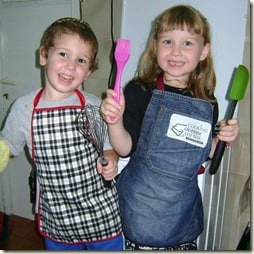This is the fourth part of a series on cooking with children. Previous posts in the series:
9 Great Reasons to Cook with Your Kids
How to Cook with a Baby in the House
How to Cook with a Toddler in the House
Modeling aprons–you can win one
Please welcome Yosefa for today’s post on preschoolers. Check out her earlier post on 4 Great Ways to Cook Cauliflower.
Cooking with preschoolers, even a single child, can feel like running a circus. You have to balance their attention and safety with timing your courses to be cooked, not burnt.
First, choose your goal: distract or involve. If you are constantly putting things in and out of the oven, or have many things boiling on the stove, you will want to distance your child from the action. Other times the food prep is G-rated, but you simply don’t have time for explaining and teaching.
Distract
Always know where your preschooler is so she doesn’t end up in front of the oven when you are trying to put a hot pot inside. Playing with pots and pans is timeless. I once bought a very cheap set of multiple sized pots that lasted one holiday season. When I no longer felt comfortable using them, I tossed the glass tops and let my kids use them. My 4.5 and 6 year old LOVE to “cook” things in these pots while I am preparing dinner.
Many children like to clean the floor or fronts of cabinets with a damp rag or baby wipe. They feel like they are helping without you needing to reorganize you menu plan or your drawers. Having a lower drawer or cabinet with child-safe Tupperware, pots, spoons, or refrigerator magnets is a great way to let your preschooler get into something while staying safe.
Magnet craft idea: If you have an overwhelming supply of promotional magnets, cut them into different shapes, paint them with bright colors, and let your kids create pictures on the fridge. It will look a lot nicer than the castles and towers my kids make with the original, unpainted magnets!
Involve
Before you start make sure that you are in the right mindset, so it is fun, not frustrating. You will need ample time, energy, and patience to stand over them and clean up afterward. Evaluate your preschooler’s dexterity to determine if they are ready to learn knife skills. Once the skills are learned under your supervision, kids can cut soft foods and spread things with dinner knives or plastic knives when your back is turned. Teaching preschoolers to find or prepare their own healthy snacks when you are too busy to help is a valuable lesson.
Counting is a terrific “helping” activity kids can do. It makes them feel smart and helpful. “The recipe says I need six eggs, how many does it look like I already put in? How many do I still need? … Can you help me count them?” I love dishes that are flexible on numbers. “Five people are coming to dinner, how many eggs do you think we should use?” Muffins can be very flexible on ingredients, conforming to what you have in the house or however many eggs, carrots, zucchini, bananas, nuts, or raisins your preschooler recommends. Even if they come out too flat or heavy, they usually taste good. I love to see the proud glow on my son’s face when I take his advice in a real grown-up activity like cooking.
Taste testing and seasoning can be the perfect place to involve young helpers. Demonstrating that you value your child’s opinion builds confidence and shows them they matter. I like to use reusable silicon muffin or mini muffin molds to hold a limited amount of seasoning. Then I let my kids decide how much should be added to the dish. I let them smell different spices to decide what would be good, or taste fresh herbs from the garden.
Menu planning and shopping with your child is a great way to teach them about making healthy, economical choices and planning balanced meals. I’m not a big planner, but I do occasionally take one well-fed and well-rested child along to help shop. It is a good place to talk about why you do or don’t buy certain things, and let your child help make decisions.
Yosefa lives in Israel with her three young children and shares her kitchen experiences on Cooking Outside the Box. For more ways kids can help, see her post on Kids in the Kitchen.
You may also enjoy:
Interview with Yosefa
10 Kid-Friendly Ways to Use Up Leftovers
12 Tips to Get Kids Used to Healthy Foods
How to Cook with a Toddler in the House


Yosefa,
These are excellent tips, esp. the one about being “in the right mindset”. My 2.5 yo (not really a preschooler yet, but close) LOVES to cook. At this stage she (tries) to count, and mix, but mostly she just eats bits of raw vegetables, sourdough, etc. as we prepare them. Which is great – then when the food comes to the table she announces what it is, and eats more of it. I hope when she is truly a preschooler – 3 or 4 years old – that I can give her more tasks where she can develop competency. (Wiping up and rearranging pots and pans is also exciting for her, but I wouldn’t say she has, uh, competency at these tasks yet. Also playing washing dishes at the sink.)
My kids also love to cook but it can be a real pain. I need some more of these tips and this attitude.
Thanks!